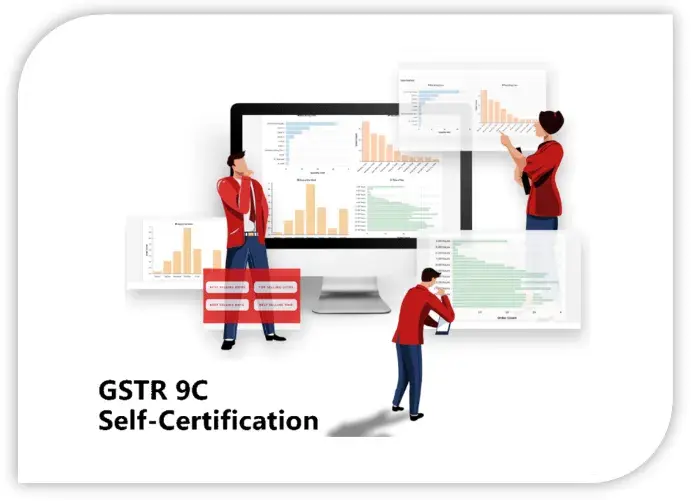Understanding GSTR 9C Self-Certification
GSTR 9C is an annual audit form applicable to all registered taxpayers with a turnover exceeding 5 crores in a specific financial year. Until FY 20-21, it required a reconciliation statement for a given financial year, which had to be filed by taxpayers and certified by Chartered Accountants (CAs)/Cost Accountants (CMAs) by December 31st.
However, starting from July 30, 2021, the government has introduced a significant change. They have notified the removal of the requirement for GST audit and certification by CAs/CMAs, allowing taxpayers to self-certify GSTR 9C starting from FY 20-21.
It's essential to stress the dynamic nature of GST rules and the need for readers to verify information with the latest official notifications. While we are sharing information, it is also important to understand the requirements for your specific business from a CA or tax consultant.
GSTR 9C Applicability and Exemptions
This form applies to all registered taxpayers, with a few exceptions:
- Casual taxable persons
- Input Service Distributors (ISD)
- Non-resident taxable persons
- Tax collectors
- Tax deductors
- Taxpayers under the Composition Scheme
- Government departments
- Taxpayers with a total turnover less than or equal to Rs. 5 crore
Changes in GSTR 9C Self-Certification
As per the Finance Act - 2021, changes were proposed to omit the certification by CAs, amending Section 35(5) of the CGST Act. These changes, recommended in the Union Budget 2021 and approved in the Finance Act, were confirmed during the 43rd GST Council Meeting. The Ministry of Finance aimed to simplify compliance requirements, suggesting that taxpayers could self-certify the reconciliation statement in GSTR 9C, replacing the need for CA certification. This change applies to the Annual Return for FY 2020-21 and was made through amendments in Sections 35 and 44 of the CGST Act, as per the GST Notification 29/2021.
Furthermore, Rule 80(3) and Part-B of the CGST Rules have been amended to specify the threshold limit for applicability. Now, GSTR-9C applies to taxpayers with an annual aggregate turnover exceeding Rs. 5 crore. The format of GSTR-9C has also been modified to accommodate FY 2020-21 and to facilitate self-certification.
Impact of GSTR 9C Self-Certification
With the removal of GST Audit and CA certification, the responsibility for GSTR 9C compliance now rests on the shoulders of CFOs and Finance Heads. This shift underscores the significance of accuracy. So, what is the impact of this change, and how can you prepare for it?
Absence of 'Maker - Checker
Without an authority figure checking the statement before official filing, it's advisable for taxpayers to ensure that their compliance undergoes thorough internal review and audit. This step offers security against potential departmental audit complications.
Increased Responsibility for Taxpayers
The Finance Ministry's move towards self-certification places an immense burden of responsibility on taxpayers and companies. Finance heads and CFOs must ensure that their teams are well-versed in the revised format of GSTR 9 and 9C. Understanding the implications of incorrect filings and associated risks is paramount.
Departmental Audit
With the removal of GST Audit by Chartered Accountants, the validity of Departmental Audits under Section 65 of the CGST Act, 2017 is less disputable. This makes it more convenient for departments to raise concerns and queries directly with taxpayers.
The government's intention is clear: while monitoring is not reducing, the responsibility for compliance is shifting more towards taxpayers than third parties. This change may lead to increased scrutiny procedures and penalties if discrepancies are discovered.
Invoking Extended Period of Limitation
The absence of Auditor Certification may lead the Department to use this as a basis for invoking an extended period of limitation for issuing Show Cause Notices (SCNs).
Precautions for Taxpayers
As the responsibility for accuracy now falls squarely on taxpayers' shoulders, certain precautions are essential:
1. Full and Proper Disclosure: Ensure all data is reported accurately under the relevant descriptions and in the correct tables. Fill in all optional fields wherever possible and provide comprehensive information. Address any unreconciled figures in Form GSTR 9C.
2. Check for Clerical Errors: GSTR 9 and GSTR 9C cannot be revised once filed. If any clerical errors occur, promptly notify the Departmental Officer in writing. Be vigilant about discrepancies in data between GST returns, such as GSTR-1 versus GSTR-3B, and reconcile them before filing returns.
3. Understand Changes in the Law: GST law has undergone numerous amendments since its inception in 2017. Stay informed about clarifications provided through press releases and adhere to them.
4. Prepare an Assessment Dossier: Conduct an annual GST Reconciliation at the PAN level, especially when the accuracy of GST filing is in question. Audit past returns, prepare a reconciliation statement, and have it audited by your statutory auditor to avoid complications. Compile all relevant details and documents at the GSTIN level.
How EaseMyGST Sapphire Assists with GSTR 9
EaseMyGST is an advanced GST software with the best GST reconciliation engine and E-document generation tool with automations and integrations for various ERPs. With EaseMyGST Sapphire's advanced reconciliation, compliance and reconciliation processes become streamlined and efficient. EMG Sapphire simplifies data matching by allowing bulk uploads of invoices across GSTINs, automatically matching purchase data with GSTR 2A from the portal, and providing well-structured mismatch results. Review discrepancies and take corrective action. You can even connect with your vendors through the portal to request rectifications. EMG Sapphire's GST Reconciliation module is designed to meet the needs of various industries and minimize manual intervention.
- One-click download of GSTR 1, 2A, and 3B data
- Reports on Tables 6, 10, 11, 13, 17, and 18 for easy auto-population
- In-built audit trail at an invoice level, offering comprehensive tracking
- Simplified one-click GSTR-9 data upload for all GSTINs
- Real-time access to reports throughout the year
- A checklist of periods for which you have fetched data from GSTN
- Quick reports highlighting differences between GSTR-2A and Table 8 of GSTR-9
FAQs
Q1. What are the consequences of not filing GSTR 9C, aside from the general penalty of Rs. 25,000?
A1. Currently, there are no other specific penalty provisions for GSTR 9C, but this may change, so stay updated.
Q2. Is there any change in late fee provisions or penal provisions for moving to self-certification from CA certification in GSTR 9C?
A2. As of now, there is no change, but keep an eye out for updates on late fees.
Q3. Is there any change in reporting requirements in Form GSTR 9C compared to the earlier GSTR 9C filed for 2019-20, aside from the certification part?
A3. There is no change except for Residual Entry in Tax Rates as "Others" to specify any other rate. All optional details of FY 19-20 remain 'optional.'
Q4. Do we have to file GSTR 9 and 9C together? What are the disadvantages of filing them separately?
A4. Filing both together is crucial to ensure that no items are missed, such as turnover and input tax. Reconciliation is critical before filing GSTR 9. GSTR 9C should ideally align with GSTR 9 data.
Q5. Is there any amendment in any of the penalty sections or audit sections?
A5. Penalty provisions and late filing provisions may be announced in the future. The change in certification is significant as it could impact the department's actions under Section 74.
Q6. If we filed GSTR-9 on/before the due date but filed GSTR 9C belatedly, what will be the late filing fee?
A6. Currently, there is no late filing fee for GSTR 9C, but this could change.
Q7. Is certification mandatory for taxpayers with a turnover above 5 crores?
A7. Yes, as long as the aggregate turnover exceeds 5 crores, GSTR 9C and self-certification are mandatory.
Q8. While filing GSTR-9 & 9C, do we need to cross-check with the sales invoice versus E-invoice?
A8. Yes, cross-checking with sales invoices versus E-invoices is important to identify non-compliance with e-invoicing provisions.
In conclusion, the shift to self-certification for GSTR 9C places a greater responsibility on taxpayers with a turnover above 5 crores. This change emphasizes the need for accuracy and internal reviews. Businesses should ensure proper disclosure, rectify errors promptly, and stay updated on GST law changes. Utilizing tools like EMG Sapphire can streamline compliance. Be vigilant about potential penalty changes and late fees. Adaptation and proactive compliance are essential in this evolving landscape.

